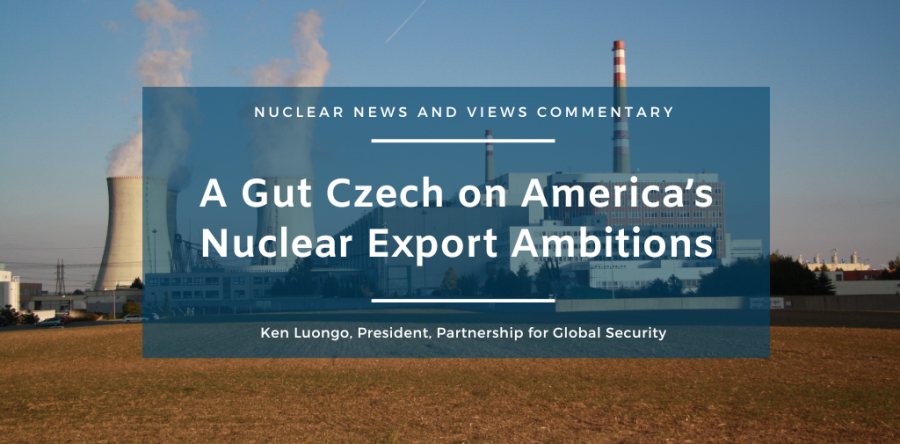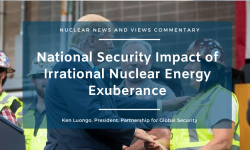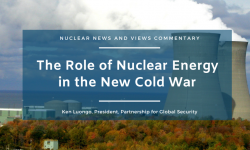As the fanfare surrounding the COP 28 decision to triple global nuclear energy by mid-century fades out, what’s coming into focus is the ill-preparedness of the U.S. to lead a global nuclear build out in a world where state support is now the new standard and American influence is receding.
The U.S. government is acting as cheerleader for American technology, and that has been successful in places like Poland and for new reactor development. But it is avoiding the hard choices that would level the playing field for American companies against other state-supported nuclear entities.
The most recent demonstration of this situation is the decision of the Czech government to toss Westinghouse and the AP-1000 out of its nuclear bid. The original plan was to build one new reactor at the Dukovany nuclear power plant. In this configuration Westinghouse was a very confident bidder.
But this month the Czech government suddenly changed the tender from one to four reactors, two each at Dukovany and Temelin. The government indicated that it “wanted all four units to be subject to binding offers to mitigate risks of price escalation and provide the highest degree of certainty on costs”.
As the head of CEZ, the Czech utility company noted, “Our goal is to get a turnkey delivery with clear guarantees, with a clear price, with clear deadlines, with clear sanctions if those deadlines are not met, and with other clear parameters.”
The demand for this level of clarity poses a high risk for private American nuclear companies as they are unable to rely on a U.S. government financial safety net. As a result, the Westinghouse-Bechtel team was unwilling to offer a binding price on the multiple units.
Comments by the Czech Prime Minister are illuminating about what may have tipped the scale. He stated that four units are, “significantly more advantageous.” And that the “price per unit could be reduced by up to 25%, which in practice means that the last fourth reactor would be more or less free at the current proposed prices.”
The two companies still in the running for the Czech business are France’s EDF and South Korea’s KHNP. EDF is a State-Owned Entity (SOE) and KHNP, is a subsidiary of KEPCO, of which the South Korean government owns more than 50%, so it is a State-Assisted Entity (SAE).
The four-pack of reactors for the Czech’s looks very much like the 2009 $20 billion deal between South Korea and the United Arab Emirates for a quad of KEPCO’s APR-1400s. In the Czech case the Koreans are offering a lower-power reactor, the APR-1000, which was certified for use in Europe in March 2023.
Another similarity to the ROK-UAE collaboration on the Barakah nuclear project is that it came in roughly on time and within the original budget. This project efficiency is unusual in the western nuclear business. And it is in contrast to the $17 billion cost overrun and 7-year delay in Westinghouse’s building of two AP-1000’s at Vogtle in Georgia.
The desire for nuclear project clarity and effectiveness was also on display at a nuclear financing summit convened last week in New York. One of the conference’s core documents was a survey of the financial community’s perspectives on nuclear energy.
It confirmed that there is support for the carbon-free and reliability attributes of nuclear energy. But it noted that cost, project timelines, and committed customers remained major concerns. These views have particular relevance for the next-generation of smaller and innovative nuclear reactors that are now under development.
The American government at the moment is fixated on the development and demonstration of these new reactors. But the sparkle of new technology is occluding the need to better prepare the market for the entry of these reactors. This is particularly true for exports.
A down-selection of a few next-gen reactor types is inevitable and the demonstration of their capability, reliability, safety, and security features on American soil will be necessary before any other nation will agree to buy them.
That period offers a window of opportunity to develop the global market to ensure that western nuclear technology is viewed as a better choice than that provided by Russia or China. But, the U.S. doesn’t seem to have a Central Command Center for nuclear market development and reactor commercialization.
It has a team of agencies with differing responsibilities and widely variable budgets. There is certainly coordination among them, but no discernable, effective strategy that can generate the necessary government financing and instill the industry discipline that can reduce risk and improve the chances of capturing international market share.
This roadmap will be necessary in a world where Russia, China, and France own their nuclear entities and other competitors like South Korea actively underwrite theirs.
As one investment firm surveyed for the financing summit noted, “the hesitation to invest in nuclear…is less about project timelines than it is about concerns regarding customer commitments”. Another noted that a better U.S. framework is required to support nuclear projects overseas, particularly an approach that “relaxes requirements for sovereign nation commitments of capital.”
This is the essence of the geopolitical fight for energy allies in which the U.S. is increasingly engaged. Sovereign support is essential for global nuclear share and the U.S. needs to quickly adapt to that reality. Otherwise, it will get hip-Czeched again and again out of key nuclear markets in this century.
Ken Luongo, President, Partnership for Global Security





